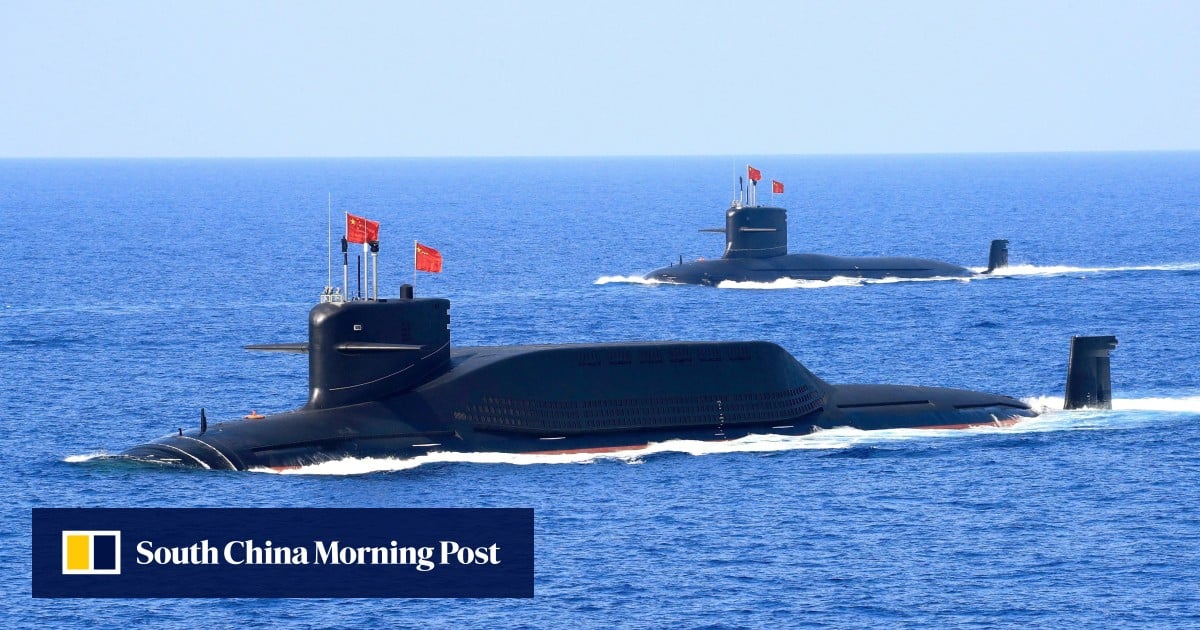- cross-posted to:
- technology@lemmy.ml
- technology
- cross-posted to:
- technology@lemmy.ml
- technology
Chinese submarines do not go brrrr
Theoretically, the development could allow a submarine to travel faster than the speed of sound without producing the mechanical noise vibration that usually gives away its location, according to the researchers.
faster than the speed of sound. that can’t be right, right?
that said, amazing tech. also I guess if you tried to produce a sonic boom underwater you’d have to go way faster than in air right? would supercavitation tear your vessel apart before then?
Maybe they mean faster than the air speed of sound but still less than the underwater speed (which is a huge margin, it turns out, 340 vs 1500 m/s)
I thought even that would be way too fast but it seems like it’s totally possible. Had no idea! https://en.wikipedia.org/wiki/VA-111_Shkval
Russia already makes supercavitating torpedoes, so should be possible to do it for subs as well https://en.wikipedia.org/wiki/VA-111_Shkval
Stuff like this makes me somewhat regret not going into engineering and physics
Given you’re commenting here you’d probably be doing this but for imperialists though
What if I just want to build elevators? Or just live my existence as a humble university faculty
University faculty have to beg for funding from the government or rich people. In STEM, most are funded through the MIC or do work that helps support it.
You’ll try to be some math nerd, let’s say. You work on graph theory that nobody cares about. Then, five years after you publish something you thought was cool but few people read, a colleague sends a graduate student your way. They ask about a pathfinding problem related to graphs and you tell them about your work and suggest a few directions of investigation and papers to read. They come back a few times so that you can help them overcome their misunderstandings. Five years later they present their DARPA-funded dissertation thanking you for helping make drone bombing routes more efficient.
Most academics don’t even care that their work supports these things. They tell themselves that career advancement and being a big nerd are what matters. And some are just plain nationalists and imperialists. If you want to be a STEM academic you’ve gotta carefully thread a needle of avoiding any military applications and building up collaborations with people that you want to benefit from your work overseas.
humble university faculty
Also almost entirely at the beck and call of the same imperialists unfortunately, especially in hard sciences and engineering.
But yeah, there’s definitely engineering jobs that don’t require you to work for lockheed out there. But the most lucrative ones seem to be the worst morally. I hear civil engineering is mostly nice, or yeah elevator mechanics make good money (usually union)
captured what I think is the whole article with a very quick ctrl+a, ctrl+c. RIP to formatting
Scientists developing China’s next-generation nuclear submarine technology say they have found a way to significantly improve the efficiency of the laser propellers that could one day drive the underwater vessels. The researchers said the new technology can produce nearly 70,000 newtons of thrust – almost the force of a commercial jet engine – using 2 megawatts of laser power emitted through the submarine’s coating of optical fibres, each thinner than a human hair – an efficiency previously thought impossible to achieve. The laser pulses not only generate thrust but also vaporise seawater, creating bubbles all over the submarine’s surface in a phenomenon known as “supercavitation” which can significantly reduce water resistance. Theoretically, the development could allow a submarine to travel faster than the speed of sound without producing the mechanical noise vibration that usually gives away its location, according to the researchers. This science fiction-like technology – called “underwater fibre laser-induced plasma detonation wave propulsion” – could have “broad application prospects in areas such as stealth propulsion for submarines”, they said. The project team is led by Ge Yang, associate professor with the school of mechanical and electronic engineering at Harbin Engineering University in Heilongjiang province, where China’s first submarine was developed. The leap in technological progress of the PLA Navy’s weaponry and equipment in recent years is closely related to this vast institution, based in northeastern China’s heavy industrial manufacturing centre. “This method can also be applied to underwater weapons, causing a supercavitation phenomenon, thereby significantly increasing the underwater range of projectiles, underwater missiles, or torpedoes,” Ge and his colleagues said.
The possibility of underwater laser propulsion was first proposed by Japanese scientists 20 years ago. The idea is to use lasers to generate plasma in water and then use the detonation wave formed by plasma expansion for propulsion. Little progress was made as the scientists found it impossible to generate a driving force in a specific direction, because of the way the detonation wave spreads from a single point in all directions. A number of countries, including China, funded extensive follow-up research, with one promising approach involving loading the force of the detonation wave on to tiny spherical particles made of metal or other materials. When these particles, known as working media, leave at high speed in a specific direction, they exert an opposite force on the submarine, according to Newton’s law. However, until now, all efforts have resulted in very low efficiency, with 1 watt of laser power generating only one millionth of a newton of thrust, which has no practical application value.
Ge and his team said they have solved the problem, designing a laser engine that improves the efficiency of converting lasers into thrust by three to four orders of magnitude. Contrary to the general view of the global research community that adding constraining devices would cause significant energy loss, the Chinese scientists added a device similar to a gun barrel to the ends of the fibres. According to the paper, the researchers solved the problem of energy loss by adjusting the shape and internal structure of the barrel, smoothing the barrel-fibre interface into a U-shape. They also used a pair of barrels to bombard the working medium particles and added carefully designed protruding structures inside the barrel to reduce the interaction and internal friction between shock waves, the paper said.
Some of the technologies behind the breakthrough originated in the aerospace defence field, where China has developed advanced plasma electric propulsion engines as part of its significant investment in hypersonic weapons research. According to the paper, this field of research, involving the physical mechanisms of detonation shock waves and propulsion media, provided valuable insights for the design and manufacture of underwater laser propellers. While a nuclear reactor on a submarine generates more than 150 megawatts of thermal power – enough for the laser propulsion system – there are still many challenges to overcome before the technology can be applied to nuclear submarines, the team said. These include heat dissipation of the optical fibres, durability in high-power and high-salinity environments, as well as matching optical fibre emission windows with the submarine’s surface anechoic tiles.
The technology would also require significant changes to submarine steering and surfacing control methods, according to the paper. The researchers said that despite these challenges, this disruptive technology aligns with the current global shift from mechanical transmission to pure electric propulsion in the new industrial revolution. In addition to potential military applications, underwater laser propulsion could also be applied to improve the efficiency of civilian ships and achieve “green shipping”, Ge’s team said.
Hero
This is pretty amazing tech. Excited to see what they do with it.
Yeah this is some sci-fi stuff right there.
“You really believe anything China says? If China almost has this tech (which they don’t and never will), then America must’ve invented it a century ago.”
America actually had high speed rail a century ago but space aliens came and dismantled it.
(America had conventional speed passenger rail a century ago but the automobile industry dismantled it.)
Silent but deadly
wow this is crazy. also good for sea life, if this is really quieter than propellers
Subs are already pretty bad for marine life, but I can’t imagine shining a bright ass laser in the abyssal zone would be doing the local ecosystem any favors.












